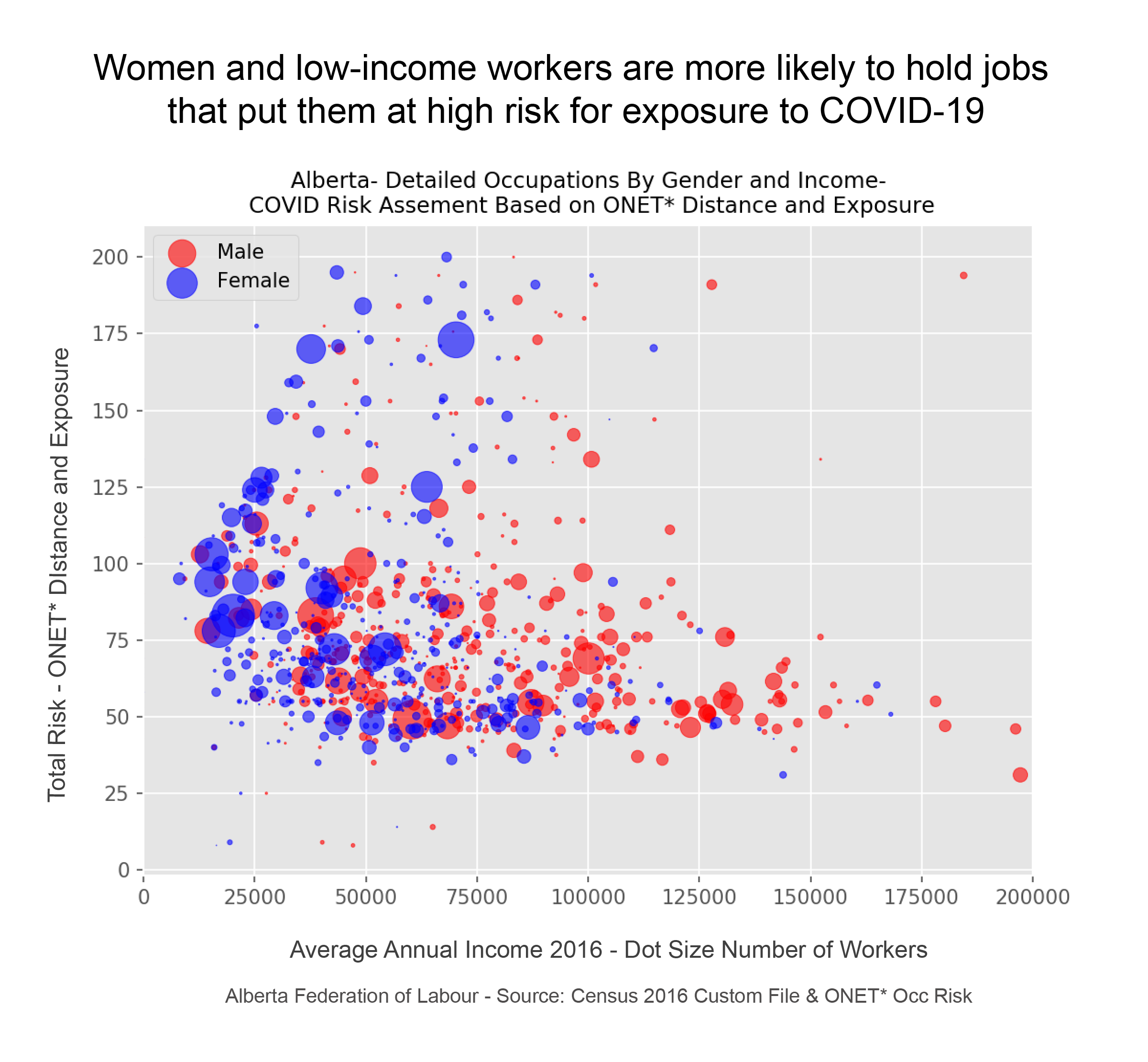Women and low-income workers most likely to be infected
As Albertans return to work, who is at the highest risk of exposure to the novel coronavirus?
The short answer is that the level of risk is fairly high for most workers – but particularly high for people working in certain occupations.
Using the 2016 Census of the Populations cross-referenced with ONET workplace health and safety data, Paul Tulloch of Living Work Analytics, has analyzed employment in Alberta for the Alberta Federation of Labour and identified the potential risk for coronavirus exposure for hundreds of different occupations and created a list of the top 100 Alberta jobs where COVID-19 risk is highest.
The analysis is based on two variables:
1) the level of physical proximity to the public experienced by workers in their jobs, and
2) the overall frequency of exposure to contagious diseases and infections at work.
These are not perfect measures of risk related to COVID-19 but rather proxy measures that provide an idea regarding high-risk occupations.
Workers in fields like meat-packing are notably missing from the list because the ONET data measures proximity to customers and the public, but not to other workers.
People should not be lulled into a false sense of security simply because their job is not on the list. Other characteristics of work and job sites – including the density of workers in a specific location – can make workers exceptionally vulnerable to contagious illnesses and diseases, including COVID-19.
What this means in practice is that if your job is on the list, it’s likely high-risk – but if it’s not, that doesn’t necessarily mean it’s low-risk. Jobs that involve working, living or travelling in close proximity to co-workers (like meat-packing, kitchens, some warehousing and manufacturing and construction work camps) should also be considered high-risk in the context of COVID-19.
With all of this mind, the list should be seen as one tool among many that can be used to identify risks and help keep Albertans safe in their workplaces.
Workers at extreme risk
Based on the analysis, the Albertan workers considered to be at extreme risk include healthcare workers such as registered nurses, doctors, dentists, veterinarians, optometrists, allied health professionals, physiotherapists, occupational therapists, laboratory technicians, radiologists, dental hygienists, licensed practical nurses and paramedics. Other occupations that face an extreme risk for contracting COVID-19 are correctional officers and flight attendants.
Workers at significant risk
Many other workers face significant risk of contracting COVID-19 in their workplaces such as police officers, firefighters, and other first responders, as well as, workers who regularly deal with the public such as bus and taxi drivers, recreation and fitness workers, librarians, delivery workers, those in food services and cashiers.
The list of workers at significant risk also includes construction workers and people who work in the trades.
Many workers in the arts also face significant risk of being exposed to COVID-19 including musicians, dancers and actors.
Workers whose job is to provide help and care for others also face significant risk including employment counsellors, early childhood educators, social workers, home support workers, translators, and school teachers and counsellors.
And of course, workers who deliver personal services such as hairstylists and barbers, massage therapists, chiropractors, and dietitians face a significant risk of contracting COVID-19 in their workplace.
Workers who are in sales and service occupations also face significant risk as well as low-income workers. Low-income workers are also especially vulnerable as they have a strong financial incentive to avoid work absences (which means they’re more likely to go to work sick) which may actually increase their risk compared to the general population.

Women face a greater risk
The COVID-19 pandemic is falling more heavily on certain subsets of the Canadian population than others. For example, women tend to dominate occupations associated with extreme risk of being exposed to COVID-19 in the workplace. Women are over-represented in many of the health care and caring occupations that put them in frequent contact with sick people.

As we begin to re-open our economy and send people back to work, our provincial government, which is responsible for workplace health and safety, must step up and do more to ensure these workers who are at a greater risk get the protection they need.
“We’ve flattened the curve, but the virus is still circulating,” says AFL president Gil McGowan. “There’s still no vaccine and no treatment. And the virus is still potentially deadly. The government has an obligation to protect the health of all Albertans; but, as people return to work, the Premier and his officials have a particular duty to workers in high-risk jobs. Extra efforts need to be made to protect these workers. If we fail in that regard, a second wave of infection – and another spike in deaths – will be the result. Let’s use this list to help target and strengthen our efforts to stop that from happening.”